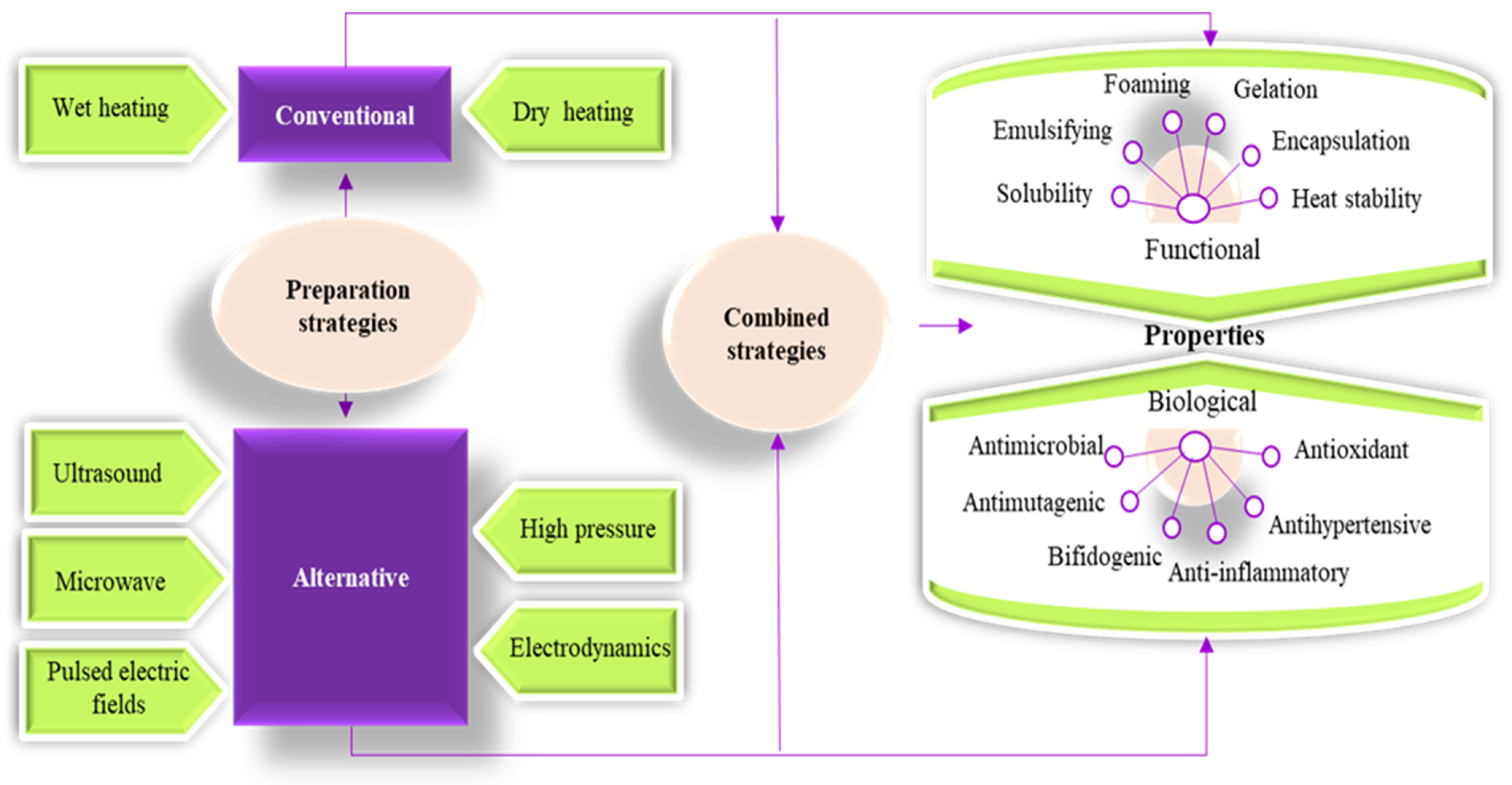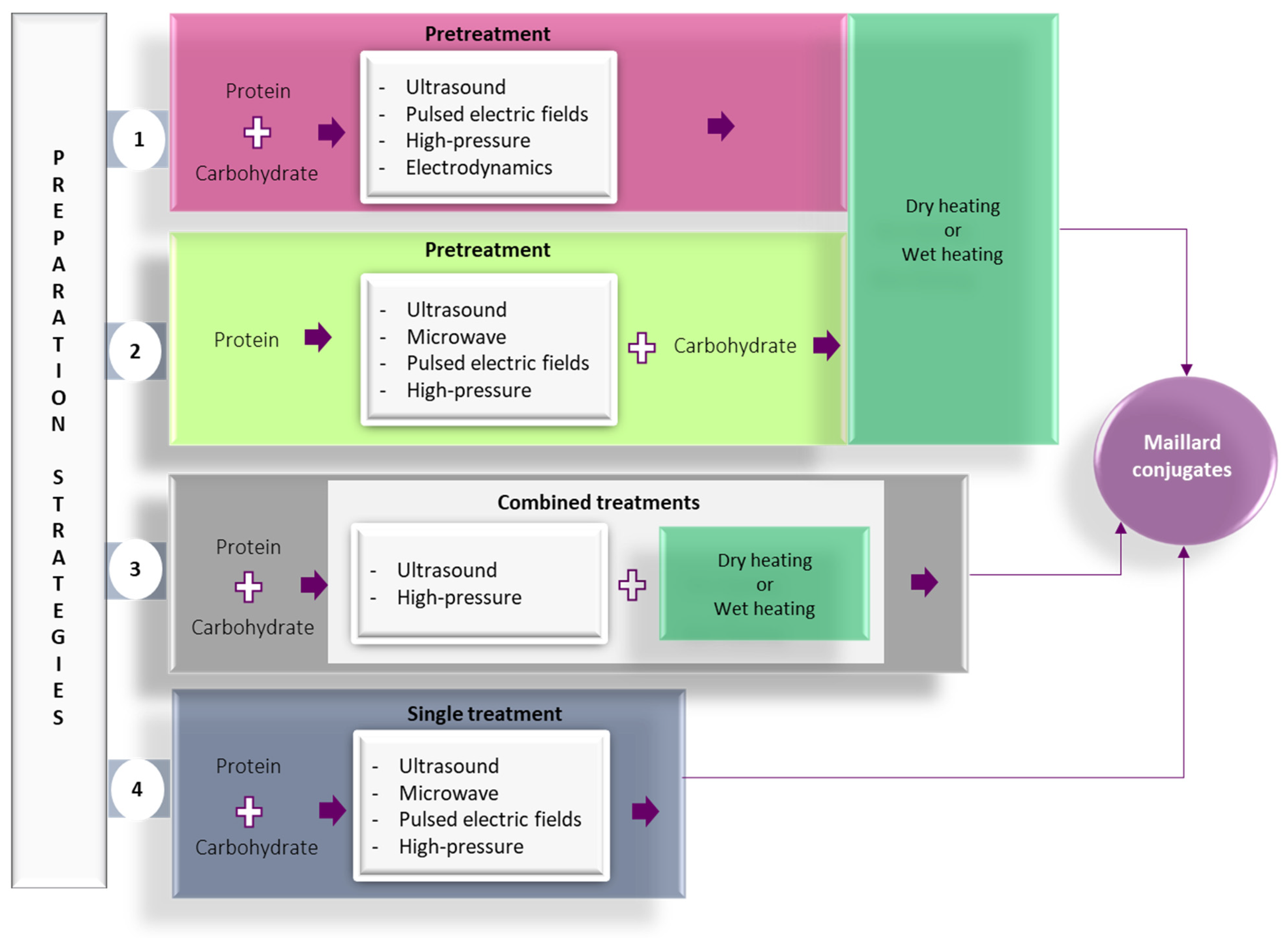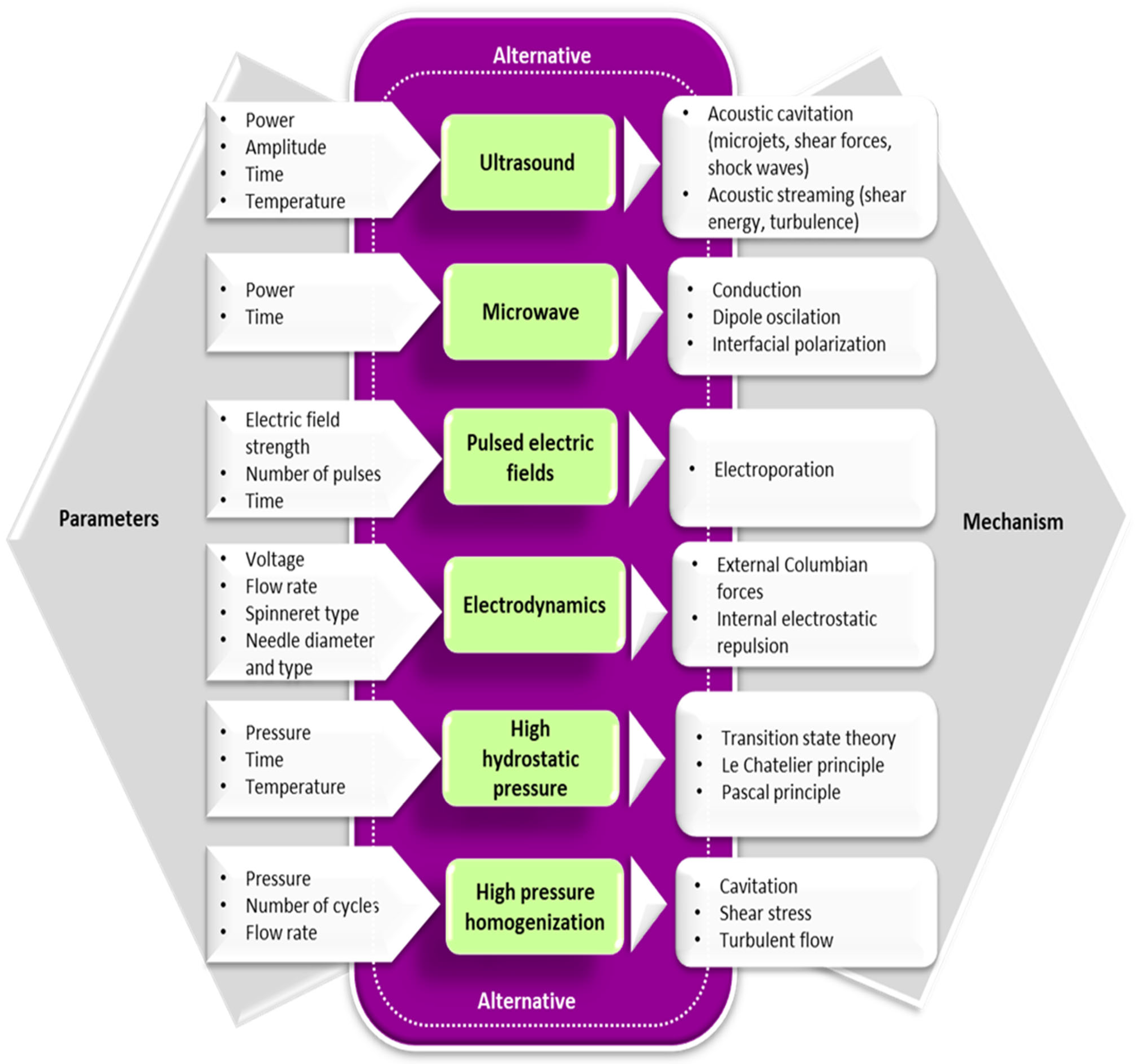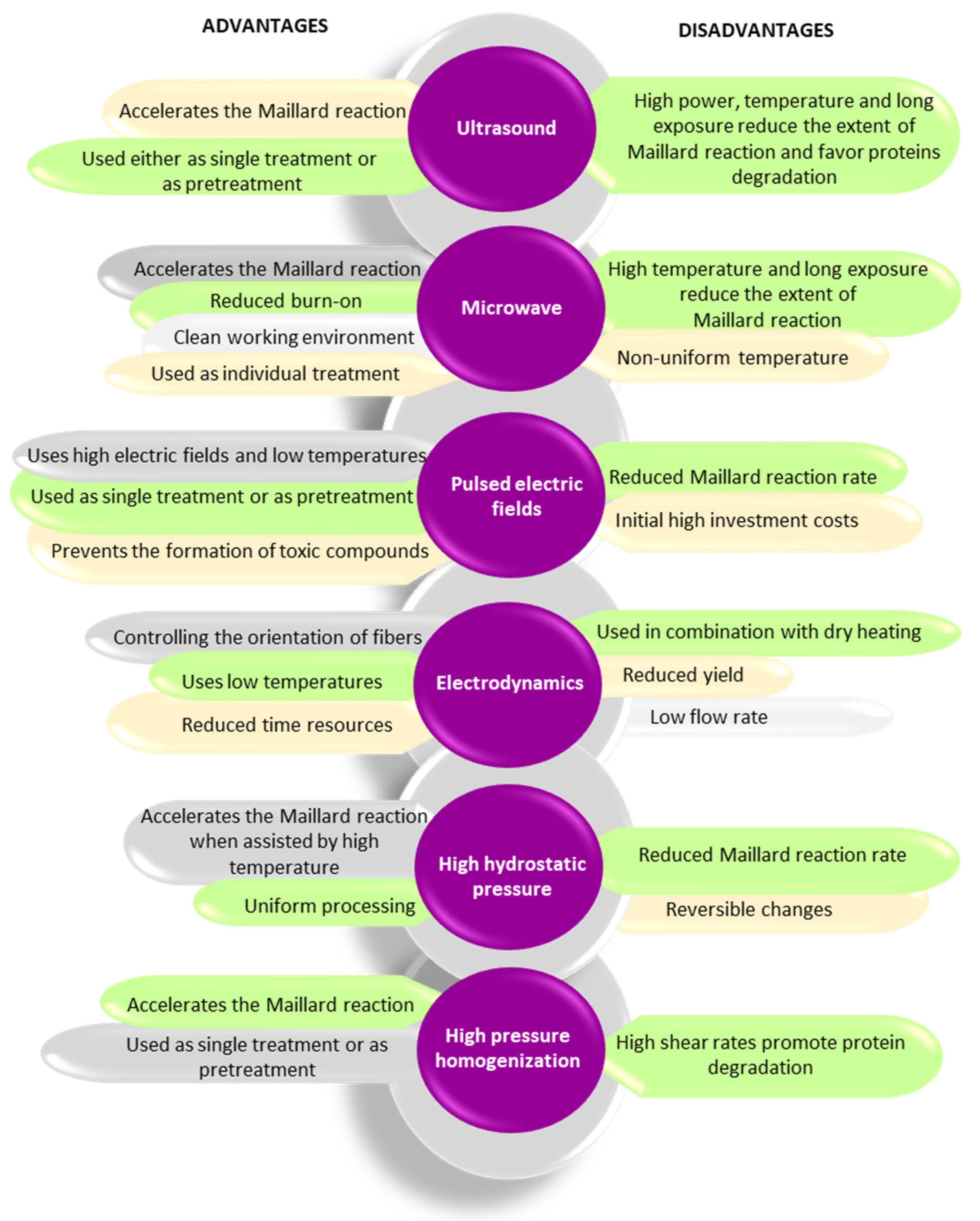Alternative Processing Options for Improving the Proteins Functionality by Maillard Conjugation
Abstract
:1. Introduction
2. Strategies to Prepare Maillard Conjugates
2.1. Ultrasound (US)
2.2. Microwave (MW)
2.3. Pulsed Electric Fields (PEF)
| Treatment Type | Protein/ Peptide Type | Carbohydrate | Ratio (w/w) | Preparation Technique According to Figure 2 | Conditions | Property | Reference | |||||
|---|---|---|---|---|---|---|---|---|---|---|---|---|
| Solubility | Emulsifying | Foaming | Heat Stability | Gelation | Antioxidant Activity | |||||||
| US | PPI | MD | 1:1 | 3 | US
| + | + | [43] | ||||
| US | PPI | Dextran | 1:1 | 3 | US
| + | + | [44] | ||||
| US | PEPI | Inulin | 4:1 to 1:1.25 | 3 | US
| + | + | + | + | + | [18] | |
| US | WPI | GAA | 4:1 to 1:1 | 3 | US
| + | + | [16] | ||||
| US | WPI | GG | 1:2 | 3 | US
| + | + | + | + | + | [20] | |
| US | SPI | MD | 2:1 | 1 | US
| + | [25] | |||||
| US | SPI | GAA | 1:1 | 3 | US
| + | + | [22] | ||||
| US | SPI | C3Gal | 200:1 | 4 | US
| + | + | [45] | ||||
| US | β-LG | Ribose | 1:1000 | 4 | US
| + | [24] | |||||
| US | β-CG | MD | 1:1 (v/v) | 3 | US
| + | [46] | |||||
| US | BPI | Dextran | 1:1 | 3 | US
| + | + | [47] | ||||
| US | MBPI | Glucose | 1:1 | 3 | US
| + | + | [48] | ||||
| US | Zein | GA | 2.66:1 | 3 | US
| + | + | + | + | [17] | ||
| US | HVPH | Sucrose | 1:1 | 1 | US
| + | [26] | |||||
| US | HNPH | Xylose | 1:19 | 3 | US
| + | + | + | [31] | |||
| US | MMP | Glucose/xylose | 20:1 | 1, 3 | US
| + | [30] | |||||
| US | GCP | Glucose | 50:1 (mL/g) | 2 | US
| + | [28] | |||||
| US | BSGP | Maltose | 2:3 | 2 | US
| - | + | [49] | ||||
| US | RPI | Dextran | 1:1 | 3 |
| + | + | + | [50] | |||
| US | BSA | Dextran | 1:2.5 | 2 | US
| + | - | - | [21] | |||
| US | Casein | Dextran | 1:2.5 | 2 | US
| + | + | + | [21] | |||
| MW | EWP | MD | 20:1 | 4 |
| +/- | + | [51] | ||||
| MW | OVA | Glucose | 1:1 | 4 |
| + | + | [33] | ||||
| MW | RDP | Sodium alginate | 1:1.88 | 4 |
| + | + | [52] | ||||
| MW | BSA | MD | 1:1–1:5 | 4 |
| + | + | + | + | + | [34] | |
| MW | RP | Dextran | 1:3 | 4 |
| +/- | + | [53] | ||||
| MW | Casein | Glucose β-cyclodextrin | 1:2 1:3 | 4 |
| + | [35] | |||||
| PEF | Glycine | Glucose | 1:1 | 4 |
| + | [54] | |||||
| PEF | WPI | Dextran | 1:1 | 4 |
| + | + | [38] | ||||
| PEF | BSA | Glucose Mannose | 1:1 | 4 |
| + | + | [40] | ||||
| PEF | BSA | Starch | 1:1 | 4 |
| +/- | + | + | [41] | |||
| ES | PEPI | MD | 1:13 | 1 | Electrospinning
| + | [55] | |||||
| ES | Gelatin | Glucose Sucrose Fructose | 10:1 | 1 | Electrospinning
| + | [56] | |||||
| LPH | PEPI | XOS | 1:3 | 2 | LPH
| + | + | + | + | + | [57] | |
| LPH+US | PEPI | XOS | 1:3 | 3 | LPH
| + | + | + | + | + | [57] | |
| DHPM | LSPI | Dextran | 1:2 | 4 |
| + | +/- | [58] | ||||
| HHP | SPI | Flaxseed gum | 1:1 | 3 |
| + | [59] | |||||
2.4. Electrodynamics
2.5. Pressure-based Processing (HP) Techniques
3. Functional Properties of Maillard Conjugates
3.1. Solubility
3.2. Emulsification
3.3. Foaming
3.4. Thermal Stability
3.5. Gelation
3.6. Encapsulation
4. Biological Properties of Maillard Conjugates
Antioxidant Activity
5. Limitations and Perspectives
6. Conclusions
Author Contributions
Funding
Conflicts of Interest
References
- Tolouie, H.; Mohammadifar, M.A.; Ghomi, H. Cold atmospheric plasma manipulation of proteins in food systems. Crit. Rev. Food Sci. 2018, 15, 2583–2597. [Google Scholar] [CrossRef] [PubMed]
- Foegeding, E.A. Food Protein Functionality—A New Model. J. Food Sci. 2015, 80, C2670–C2677. [Google Scholar] [CrossRef] [PubMed]
- Foegeding, E.A.; Davis, J.P. Food Hydrocolloids Food protein functionality: A comprehensive approach. Food Hydrocoll. 2011, 25, 1853–1864. [Google Scholar] [CrossRef]
- Nooshkam, M.; Varidi, M.; Verma, D.K. Functional and biological properties of Maillard conjugates and their potential application in medical and food: A review. Food Res. Int. 2020, 131, 109003. [Google Scholar] [CrossRef] [PubMed]
- de Oliveira, F.C.; Coimbra, J.S.R.; de Oliveira, E.B.; Giraldo Zuñiga, A.D.; Garcia Rojas, E. Food Protein-polysaccharide Conjugates Obtained via the Maillard Reaction: A Review. Crit. Rev. Food Sci. 2016, 56, 1108–1125. [Google Scholar] [CrossRef]
- Rannou, C.; Laroque, D.; Renault, E.; Prost, C.; Sérot, T. Mitigation strategies of acrylamide, furans, heterocyclic amines and browning during the Maillard reaction in foods. Food Res. Int. 2016, 90, 154–176. [Google Scholar] [CrossRef]
- Zhang, S.; Wang, K.; Qin, Y.; Zhu, S.; Gao, Q.; Liu, D. The synthesis, biological activities and applications of protein–polysaccharide conjugates in food system: A review. Food Qual. Saf. 2023, 7, fyad006. [Google Scholar] [CrossRef]
- Zha, F.; Gao, K.; Rao, J.; Chen, B. Maillard-driven chemistry to tune the functionality of pea protein: Structure characterization, site-specificity, and aromatic profile. Trends Food Sci. Technol. 2021, 114, 658–671. [Google Scholar] [CrossRef]
- Naik, R.R.; Wang, Y.; Selomulya, C. Improvements of plant protein functionalities by Maillard conjugation and Maillard reaction products. Crit. Rev. Food Sci. 2022, 62, 7036–7061. [Google Scholar] [CrossRef]
- Sedaghat Doost, A.; Nikbakht Nasrabadi, M.; Wu, J.; A’yun, Q.; Van der Meeren, P. Maillard conjugation as an approach to improve whey proteins functionality: A review of conventional and novel preparation techniques. Trends Food Sci. Technol. 2019, 91, 1–11. [Google Scholar] [CrossRef]
- Perusko, M.; Al-Hanish, A.; Velickovic, T.C.; Stanic-Vucinic, D. Macromolecular crowding conditions enhance glycation and oxidation of whey proteins in ultrasound-induced Maillard reaction. Food Chem. 2015, 177, 248–257. [Google Scholar] [CrossRef] [PubMed]
- Ke, C.; Li, L. Influence mechanism of polysaccharides induced Maillard reaction on plant proteins structure and functional properties: A review. Carboh Polym. 2023, 302, 120430. [Google Scholar] [CrossRef] [PubMed]
- O’Mahony, J.A.; Drapala, K.P.; Mulcahy, E.M.; Mulvihill, D.M. Controlled glycation of milk proteins and peptides: Functional properties. Int. Dairy. J. 2017, 67, 16–34. [Google Scholar] [CrossRef]
- Liu, J.; Tu, Z.; Shao, Y.-H.; Wang, H.; Liu, G.-X.; Sha, X.-M.; Zhang, L.; Yang, P. Improved antioxidant activity and glycation of α-lactalbumin after ultrasonic pretreatment revealed by high-resolution mass spectrometry. J. Agric. Food Chem. 2017, 65, 10317–11032. [Google Scholar] [CrossRef] [PubMed]
- Liu, G.X.; Tu, Z.C.; Yang, W.; Wang, H.; Zhang, L.; Ma, D.; Huang, T.; Liu, J.; Li, X. Investigation into allergenicity reduction and glycation sites of glycated β-lactoglobulin with ultrasound pretreatment by high-resolution mass spectrometry. Food Chem. 2018, 252, 99–107. [Google Scholar] [CrossRef]
- Chen, W.; Ma, X.; Wang, W.; Lv, R.; Guo, M.; Ding, T.; Ye, X.; Miao, S.; Liu, D. Preparation of modified whey protein isolate with gum acacia by utrasound Maillard reaction. Food Hydrocoll. 2019, 95, 298–307. [Google Scholar] [CrossRef]
- Ma, C.; Jiang, W.; Chen, G.; Wang, Q.; McClements, D.J.; Liu, X.; Liu, F.; Ngai, T. Sonochemical effects on formation and emulsifying properties of zein-gum Arabic complexes. Food Hydrocoll. 2021, 114, 106557. [Google Scholar] [CrossRef]
- Jiang, W.; Wang, Y.; Ma, C.; Julian McClements, D.; Liu, F.; Liu, X. Pea protein isolate-inulin conjugates prepared by pH-shift treatment and ultrasonic-enhanced glycosylation: Structural and functional properties. Food Chem. 2022, 384, 132511. [Google Scholar] [CrossRef]
- Zhao, C.B.; Zhou, L.Y.; Liu, J.Y.; Zhang, Y.; Chen, Y.; Wu, F. Effect of ultrasonic pretreatment on physicochemical characteristics and rheological properties of soy protein/sugar Maillard reaction products. J. Food Sci. Technol. 2016, 53, 2342–2351. [Google Scholar] [CrossRef]
- Dev, M.J.; Pandit, A.B.; Singhal, R.S. Ultrasound assisted vis-à-vis classical heating for the conjugation of whey protein isolate-gellan gum: Process optimization, structural characterization and physico-functional evaluation. Innov. Food Sci. Emerg. 2021, 72, 102724. [Google Scholar] [CrossRef]
- Cui, H.; Zang, Z.; Jiang, Q.; Bao, Y.; Wu, Y.; Li, J.; Chen, Y.; Liu, X.; Yang, S.; Si, X.; et al. Utilization of ultrasound and glycation to improve functional properties and encapsulated efficiency of proteins in anthocyanins. Food Chem. 2023, 419, 135899. [Google Scholar] [CrossRef]
- Mu, L.; Zhao, M.; Yang, B.; Zhao, H.; Cui, C.; Zhao, Q. Effect of ultrasonic treatment on the graft reaction between soy protein isolate and gum acacia and on the physicochemical properties of conjugates. J. Agric. Food Chem. 2010, 58, 4494–4499. [Google Scholar] [CrossRef] [PubMed]
- Li, C.; Huang, X.; Peng, Q.; Shan, Y.; Xue, F. Physicochemical properties of peanut protein isolate-glucomannan conjugates prepared by ultrasonic treatment. Ultrason. Sonochem. 2014, 21, 1722–1727. [Google Scholar] [CrossRef] [PubMed]
- Stanic-Vucinic, D.; Prodic, I.; Apostolovic, D.; Nikolic, M.; Cirkovic Velickovic, T. Structure and antioxidant activity of β-lactoglobulin-glycoconjugates obtained by high-intensity-ultrasound-induced Maillard reaction in aqueous model systems under neutral conditions. Food Chem. 2013, 138, 590–599. [Google Scholar] [CrossRef] [PubMed]
- Zhao, C.; Yin, H.; Yan, J.; Niu, X.; Qi, B.; Liu, J. Structure and acid-induced gelation properties of soy protein isolate-maltodextrin glycation conjugates with ultrasonic pretreatment. Food Hydrocoll. 2021, 112, 106278. [Google Scholar] [CrossRef]
- Abdelhedi, O.; Mora, L.; Jemil, I.; Jridi, M.; Toldrá, F.; Nasri, M.; Nasri, R. Effect of ultrasound pretreatment and Maillard reaction on structure and antioxidant properties of ultrafiltrated smooth-hound viscera proteins-sucrose conjugates. Food Chem. 2017, 230, 507–515. [Google Scholar] [CrossRef]
- Liu, L.; Li, X.; Du, L.; Zhang, X.; Yang, W.; Zhang, H. Effect of ultrasound assisted heating on structure and antioxidant activity of whey protein peptide grafted with galactose. LWT Food Sci. Technol. 2019, 109, 130–136. [Google Scholar] [CrossRef]
- Yang, X.; Li, Y.; Li, S.; Ren, X.; Olayemi Oladejo, A.; Lu, F.; Ma, H. Effects and mechanism of ultrasound pretreatment of protein on the Maillard reaction of protein-hydrolysate from grass carp (Ctenopharyngodon idella). Ultrason. Sonochem. 2020, 64, 104964. [Google Scholar] [CrossRef]
- Yang, Z.; Hu, M. Effect of ultrasonic pretreatment on flavor characteristics of brewer’s yeast-peanut meal hydrolysate/xylose Maillard reaction products. J. Food Process. Preserv. 2022, 46, e16699. [Google Scholar] [CrossRef]
- Dong, Z.Y. Effects of ultrasonic treatment on Maillard reaction and product characteristics of enzymatic hydrolysate derived from mussel meat. J. Food Process. Eng. 2019, 42, e13206. [Google Scholar] [CrossRef]
- Ren, S.; Fu, J.; He, F.; Chai, T.; Yu-ting, L.; Jin, D.; Chen, Y. Characteristics and antioxidant properties of Harpadon nehereus protein hydrolysate-xylose conjugates obtained from the Maillard reaction by ultrasound-assisted wet heating in a natural deep eutectic solvents system. J. Sci. Food Agric. 2023, 103, 2273–2282. [Google Scholar] [CrossRef] [PubMed]
- Liu, C.; Ma, X. Study on the mechanism of microwave modified wheat protein fiber to improve its mechanical properties. J. Cereal Sci. 2016, 70, 99–107. [Google Scholar] [CrossRef]
- Hu, Y.; Chen, H.; Xiao, L.; Chu, L.; Wang, S.; Wang, H. Comparison of ovalbumin glycation by microwave irradiation and conventional heating. LWT Food Sci. Technol. 2019, 116, 108560. [Google Scholar] [CrossRef]
- Nasrollahzadeh, F.; Varidi, M.; Koocheki, A.; Hadizadeh, F. Effect of microwave and conventional heating on structural, functional and antioxidant properties of bovine serum albumin-maltodextrin conjugates through Maillard reaction. Food Res. Int. 2017, 100, 289–297. [Google Scholar] [CrossRef]
- Bi, W.; Zhao, W.; Li, X.; Ge, W.; Muhammad, Z.; Wang, H.; Du, L. Study on microwave-accelerated casein protein grafted with glucose and β-cyclodextrin to improve the gel properties. Int. J. Food Sci. Technol. 2015, 50, 1429–1435. [Google Scholar] [CrossRef]
- Guan, J.-J.; Zhang, T.-B.; Hui, M.; Yin, H.-C.; Qiu, A.-Y.; Liu, X.-Y. Mechanism of microwave-accelerated soy protein isolate–saccharide graft reactions. Food Res. Int. 2011, 44, 2647–2654. [Google Scholar] [CrossRef]
- Yang, W.; Tu, Z.; Wang, H.; Zhang, L.; Kaltashov, I.; Zhao, Y.; Niu, C.; Yao, H.; Ye, W. The mechanism of reduced IgG/IgE-binding of β-lactoglobulin by pulsed electric field pretreatment combined with glycation revealed by ECD/FTICR-MS. Food Funct. 2018, 9, 417–425. [Google Scholar] [CrossRef]
- Sun, W.; Yu, S.; Yang, X.; Wang, J.; Zhang, J.; Zhang, Y.; Zheng, E. Study on the rheological properties of heat-induced whey protein isolate–dextran conjugate gel. Food Res. Int. 2011, 44, 3259–3263. [Google Scholar] [CrossRef]
- Guan, Y.G.; Lin, H.; Han, Z.; Wang, J.; Yu, S.J.; Zeng, X.A.; Liu, Y.Y.; Xu, C.H.; Sun, W.W. Effects of pulsed electric field treatment on a bovine serum albumin-dextran model system, a means of promoting the Maillard reaction. Food Chem. 2010, 123, 275–280. [Google Scholar] [CrossRef]
- Jian, W.; Wang, L.; Wu, L.; Sun, Y.M. Physicochemical properties of bovine serum albumin-glucose and bovine serum albumin-mannose conjugates prepared by pulsed electric fields treatment. Molecules 2018, 23, 570. [Google Scholar] [CrossRef]
- Taha, A.; Casanova, F.; Simonis, P.; Gomaa, M.A.E. Pulsed electric field-assisted glycation of bovine serum albumin / starch conjugates improved their emulsifying properties. Innov. Food Sci. Emerg. 2022, 82, 103190. [Google Scholar] [CrossRef]
- Fallavena, L.P.; Rodrigues, N.; Damasceno Ferreira Marczak, L.; Domeneghini Mercali, G. Formation of advanced glycation end products by novel food processing technologies: A review. Food Chem. 2022, 393, 133338. [Google Scholar] [CrossRef] [PubMed]
- Chen, L.; Chen, J.; Wu, K.; Yu, L. Improved low pH emulsification properties of glycated peanut protein isolate by ultrasound Maillard reaction. J. Agric. Food Chem. 2016, 64, 5531–5538. [Google Scholar] [CrossRef] [PubMed]
- Li, C.; Xue, H.; Chen, Z.; Ding, Q.; Wang, X. Comparative studies on the physicochemical properties of peanut protein isolate-polysaccharide conjugates prepared by ultrasonic treatment or classical heating. Food Res. Int. 2014, 57, 1–7. [Google Scholar] [CrossRef]
- Xue, F.; Li, C.; Adhikari, B. Physicochemical properties of soy protein isolates-cyanidin-3-galactoside conjugates produced using free radicals induced by ultrasound. Ultrason. Sonochem. 2020, 64, 104990. [Google Scholar] [CrossRef]
- Zhang, B.; Chi, Y.; Li, B. Effect of ultrasound treatment on the wet heating Maillard reaction between β-conglycinin and maltodextrin and on the emulsifying properties of conjugates. Eur. Food Res. Technol. 2014, 238, 129–138. [Google Scholar] [CrossRef]
- Xue, F.; Wu, Z.; Tong, J.; Zheng, J.; Li, C. Effect of combination of high-intensity ultrasound treatment and dextran glycosylation on structural and interfacial properties of buckwheat protein isolates. Biosci. Biotechnol. Biochem. 2017, 81, 1891–1898. [Google Scholar] [CrossRef]
- Wang, Z.; Han, F.; Sui, X.; Qi, B.; Yang, Y.; Zhang, H.; Wang, R.; Jiang, L. Effect of ultrasound treatment on the wet heating Maillard reaction between mung bean [Vigna radiate (L.)] protein isolates and glucose and on structural and physico-chemical properties of conjugates. J. Sci. Food Agric. 2016, 96, 1532–1540. [Google Scholar] [CrossRef]
- Li, Q.; Li, W.; Li, L.; Zong, X.; Coldea, E. Enhancing the foaming properties of brewer’s spent grain protein by ultrasound treatment and glycation reaction. Food Funct. 2023, 14, 2781–2792. [Google Scholar] [CrossRef]
- Qu, W.; Zhang, X.; Chen, W.; Wang, Z.; He, R.; Ma, H. Effects of ultrasonic and graft treatments on grafting degree, structure, functionality, and digestibility of rapeseed protein isolate-dextran conjugates. Ultrason. Sonochem. 2018, 42, 250–259. [Google Scholar] [CrossRef]
- Chang, C.; Su, Y.; Gu, L.; Li, J.; Yang, Y. Microwave induced glycosylation of egg white protein: Study on physicochemical properties and baking performance. Food Hydrocoll. 2021, 118, 106569. [Google Scholar] [CrossRef]
- Meng, X.; Li, T.; Song, T.; Chen, C.; Venkitasamy, C.; Pan, Z.; Zhang, H. Solubility, structural properties, and immunomodulatory activities of rice dreg protein modified with sodium alginate under microwave heating. Food Sci. Nutr. 2019, 7, 2556–2564. [Google Scholar] [CrossRef] [PubMed]
- Cheng, Y.; Mu, D.; Jiao, Y.; Xu, Z.; Chen, M. Microwave-assisted maillard reaction between rice protein and dextran induces structural changes and functional improvements. J. Cereal Sci. 2021, 97, 103134. [Google Scholar] [CrossRef]
- Wang, J.; Guan, Y.; Yu, S.; Zeng, X.; Liu, Y.; Yuan, S.; Xu, R. Study on the Maillard Reaction Enhanced by Pulsed Electric Field in a Glycin–Glucose Model System. Food Bioprocess. Technol. 2011, 4, 469–474. [Google Scholar] [CrossRef]
- Kutzli, I.; Griener, D.; Gibis, M. Improvement of emulsifying behavior of pea proteins as plant-based emulsifiers via Maillard- induced glycation in electrospun pea protein–maltodextrin fiber. Food Funct. 2020, 11, 4049–4056. [Google Scholar] [CrossRef] [PubMed]
- Kwak, H.W.; Park, J.; Yun, H.; Jeon, K.H.; Kang, D.W. Effect of crosslinkable sugar molecules on the physico-chemical and antioxidant properties of fish gelatin nanofibers. Food Hydrocoll. 2021, 111, 106259. [Google Scholar] [CrossRef]
- Zhao, S.; Huang, Y.; Julian, D.; Liu, X.; Wang, P.; Liu, F. Improving pea protein functionality by combining high-pressure homogenization with an ultrasound-assisted Maillard reaction. Food Hydrocoll. 2022, 126, 107441. [Google Scholar] [CrossRef]
- Zheng, Y.; Li, Z.; Lu, Z.; Wu, F.; Fu, G.; Zheng, B.; Tian, Y. Structural characteristics and emulsifying properties of lotus seed protein isolate-dextran glycoconjugates induced by a dynamic high pressure microfluidization Maillard reaction. LWT Food Sci. Technol. 2022, 160, 113309. [Google Scholar] [CrossRef]
- Liu, D.; Zhang, L.; Wang, Y.; Li, Z.; Wang, Z.; Han, J. Effect of high hydrostatic pressure on solubility and conformation changes of soybean protein isolate glycated with flaxseed gum. Food Chem. 2020, 333, 127530. [Google Scholar] [CrossRef]
- Niu, B.; Shao, P.; Luo, Y.; Sun, P. Recent advances of electrosprayed particles as encapsulation systems of bioactives for food application. Food Hydrocoll. 2020, 99, 10537. [Google Scholar] [CrossRef]
- Wen, P.; Zong, M.H.; Linhardt, R.J.; Feng, K.; Wu, H. Electrospinning: A novel nano-encapsulation approach for bioactive compounds. Trends Food Sci. Technol. 2017, 70, 56–68. [Google Scholar] [CrossRef]
- Baier, S.; Given, P.; Kanjanapongkul, K.; Weiss, J. Formation of Conjugated Protein by Electrospinning. EP2834188A1, 2016. Available online: https://patents.google.com/patent/EP2834188A1/en (accessed on 17 September 2023).
- Kutzli, I.; Gibis, M.; Baier, S.K.; Weiss, J. Electrospinning of whey and soy protein mixed with maltodextrin—Influence of protein type and ratio on the production and morphology of fibers. Food Hydrocoll. 2019, 93, 206–214. [Google Scholar] [CrossRef]
- Zhang, Y.; Deng, L.; Zhong, H.; Zou, Y.; Qin, Z.; Li, Y.; Zhang, H. Impact of glycation on physical properties of composite gluten/zein nanofibrous films fabricated by blending electrospinning. Food Chem. 2022, 366, 130587. [Google Scholar] [CrossRef] [PubMed]
- Martinez-Monteagudo, S.; Saldana, M. Chemical Reactions in Food Systems at High Hydrostatic Pressure. Food Eng. Rev. 2014, 6, 105–127. [Google Scholar] [CrossRef]
- Galazka, V.B.; Smith, D.; Ledward, D.A.; Dickinson, E. Complexes of bovine serum albumin with sulphated polysaccharides: Effects of pH, ionic strength and high pressure treatment. Food Chem. 1999, 64, 303–310. [Google Scholar] [CrossRef]
- Rada-Mendoza, M.; Villamiel, M.; Molina, E.; Olano, A. Effects of heat treatment and high pressure on the subsequent lactosylation of β-lactoglobulin. Food Chem. 2006, 99, 651–655. [Google Scholar] [CrossRef]
- Avila Ruiz, G.; Xi, B.; Minor, M.; Sala, G.; Van Boekel, M.; Fogliano, V.; Stieger, M. High-pressure–high-temperature processing reduces maillard reaction and viscosity in whey protein–sugar solutions. J. Agric. Food Chem. 2016, 64, 7208–7215. [Google Scholar] [CrossRef]
- Harte, F. Food processing by high pressure homogenization. In High Pressure Processing of Food. Principles, Technology and Applications; Balasubramaniam, V.M., Barbosa-Cánovas, G.V., Lelieveld Huub, L.M., Eds.; Springer Science+Business Media: New York, NY, USA, 2016; pp. 123–141. [Google Scholar]
- Nooshkam, M.; Varidi, M. Maillard conjugate-based delivery systems for the encapsulation, protection, and controlled release of nutraceuticals and food bioactive ingredients: A review. Food Hydrocoll. 2020, 100, 105389. [Google Scholar] [CrossRef]
- Wu, B.; Chai, X.; He, A.; Huang, Z.; Chen, S.; Rao, P.; Ke, L.; Xiang, L. Inhibition of acrylamide toxicity in vivo by arginine-glucose maillard reaction products. Food Chem. Toxicol. 2021, 154, 112315. [Google Scholar] [CrossRef]
- Fu, Y.; Zhang, Y.; Soladoye, O.; Aluko, R. Maillard reaction products derived from food protein-derived peptides: Insights into flavor and bioactivity. Crit. Rev. Food Sci. 2019, 60, 3429–3442. [Google Scholar] [CrossRef]
- Yu, H.; Seow, Y.; Ong, P.K.C.; Zhou, W. Generating Maillard reaction products in a model system of D-glucose and L-serine by continuous high-intensity ultrasonic processing. Innov. Food Sci. Emerg. 2016, 36, 260–268. [Google Scholar] [CrossRef]




Disclaimer/Publisher’s Note: The statements, opinions and data contained in all publications are solely those of the individual author(s) and contributor(s) and not of MDPI and/or the editor(s). MDPI and/or the editor(s) disclaim responsibility for any injury to people or property resulting from any ideas, methods, instructions or products referred to in the content. |
© 2023 by the authors. Licensee MDPI, Basel, Switzerland. This article is an open access article distributed under the terms and conditions of the Creative Commons Attribution (CC BY) license (https://creativecommons.org/licenses/by/4.0/).
Share and Cite
Dumitrașcu, L.; Borda, D.; Aprodu, I. Alternative Processing Options for Improving the Proteins Functionality by Maillard Conjugation. Foods 2023, 12, 3588. https://doi.org/10.3390/foods12193588
Dumitrașcu L, Borda D, Aprodu I. Alternative Processing Options for Improving the Proteins Functionality by Maillard Conjugation. Foods. 2023; 12(19):3588. https://doi.org/10.3390/foods12193588
Chicago/Turabian StyleDumitrașcu, Loredana, Daniela Borda, and Iuliana Aprodu. 2023. "Alternative Processing Options for Improving the Proteins Functionality by Maillard Conjugation" Foods 12, no. 19: 3588. https://doi.org/10.3390/foods12193588
APA StyleDumitrașcu, L., Borda, D., & Aprodu, I. (2023). Alternative Processing Options for Improving the Proteins Functionality by Maillard Conjugation. Foods, 12(19), 3588. https://doi.org/10.3390/foods12193588









